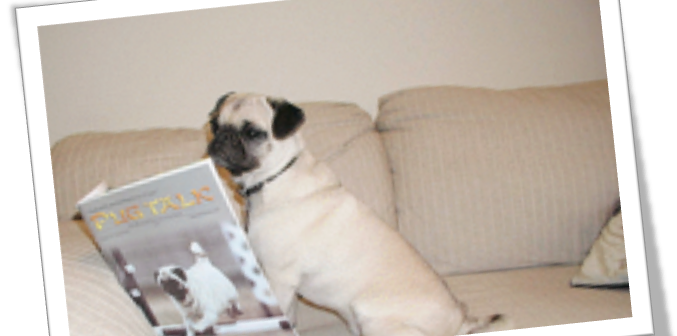July 21, 2018 (Originally published on July 27, 2010)
Linda Lombardi
Staff Writer
A Pet’s Life
“It’s so nice you can bring your dog to work.” That’s what people say when they meet me and my pug Lilly at our part-time job at a local pet boutique.
Most of the time, yes – but maybe not on that day when a child in a stroller tossed a few tiny dark objects on the floor of the store.
The pug and I saw the raisins at the same time, but she’s faster and closer to the ground. I got one, but as she gobbled up the other two, I groaned at the vision of my day’s wages going directly into my vet’s bank account.
A number of human foods can be toxic to dogs. Another time, Lilly finished up an unattended roll of chocolate caramels (blame that one on my husband). As most people know, dogs should not eat chocolate, but it does take a certain minimum amount to cause problems. The candies were milk chocolate, which has less of the toxic ingredient than dark, and she’d only eaten two or three. So in that case, I was more concerned about the effects of her also having eaten the foil wrappers.
But grapes and raisins are different. Two raisins seemed like a tiny amount, but I recalled reading that scientists are not certain what is the minimum needed to cause illness.
I phoned my vet, hoping that this was one of those cases where you can’t believe everything you read on the internet. Unfortunately, she confirmed my recollection, and said that the safest thing to do was bring Lilly in so they could induce vomiting.
There was no time for a second opinion while the pug’s stomach was getting busy digesting the possibly perilous snack, so off we went. But later I spoke to Dr. Safdar Khan, director of toxicology at the ASPCA Animal Poison Control Center, who was one of the authors of the first published research that described grapes and raisins causing serious kidney damage in dogs. Would he have made the same recommendation?
“That’s the tricky question,” he said.
In their 2005 study, the lowest toxic dose of raisins was 2.8 grams per kilogram of body weight. (The amount is larger for grapes, which are less concentrated.) Translating that into something more understandable, that’s nearly one ounce for my 18 pound dog, and the familiar individual size box of raisins holds 1 ½ half ounces.
So that’s a lot more than two raisins. But, Dr Khan cautioned, “However, there were a couple of cases which did not follow that rule. In those, the evidence of kidney damage did occur at a smaller amount.”
Scientists don’t know why grapes and raisins are toxic, although it doesn’t appear to matter what variety of grape, and organically grown are no safer. They also have no idea what makes some dogs react to smaller amounts. “They may just be supersensitive individuals,” Khan says, comparing it to human differences. Some people can take four ibuprofen tablets with no problems and other may experience side effects from just one.
Khan told me that he no longer gets particularly excited about one or two raisins, but that it’s important to understand there is a risk, however small. If there are individual differences, there’s no way to predict whether your dog is one of the “supersensitive” ones. And since inducing vomiting isn’t a particularly risky or expensive treatment, I felt vindicated in my decision. It was better to be safe than sorry.
You may decide differently; there’s also the possibility that inducing vomiting won’t be successful. In those cases, you need to carefully monitor your dog. “Kidney damage is a serious situation, and it affects a lot of body systems,” he says. Loss of appetite may be an early sign within a few hours or a day, as well as lethargy. One to two days later, the damage will be apparent via blood testing.
Grapes, raisins and chocolate aren’t the only foods you should keep away from your dog. They’re uniquely sensitive to macadamia nuts, which can cause weakness in the hind legs, although it usually goes away in a day or so without treatment, says Khan. Other nuts are not intrinsically dangerous, but if they’re salted, the large amount of salt can be harmful. Onions and garlic can cause damage to blood cells, and never feed your dog anything moldy.
When Khan mentioned the latter problem, that people often gave their dogs moldy cheese instead of throwing it away, that got my attention. “What about cutting the mold off and eating what’s left?” I said. “Because I do that and eat it myself.”
But just like the chocolate that I consume in massive quantities, the carefully trimmed cheese may be OK for me, but it’s not OK for my dog. “Species sensitivity is a science now,” Khan observes – meaning that your dog may be a member of your family, but she’s not a human. There are many ways in which her body doesn’t work the same way, and those are just some of the realities of knowing and loving your pet.
For a list of foods and medications that are dangerous to your pets, visit these ASPCA websites:
http://www.aspca.org/pet-care/poison-control/top-10-human-medications-that-poison-our-pets.html
http://www.aspca.org/pet-care/poison-control/people-foods.html



